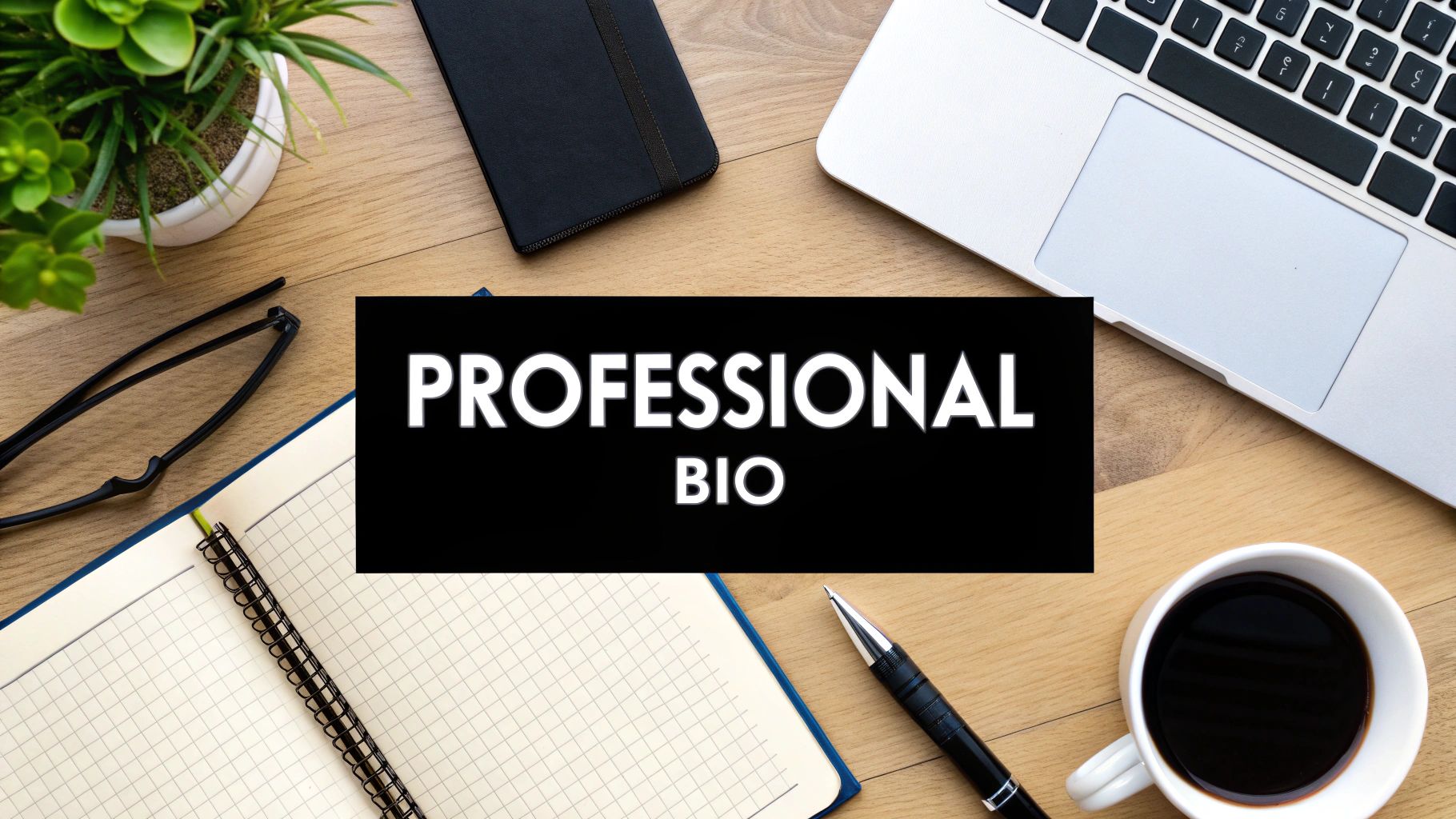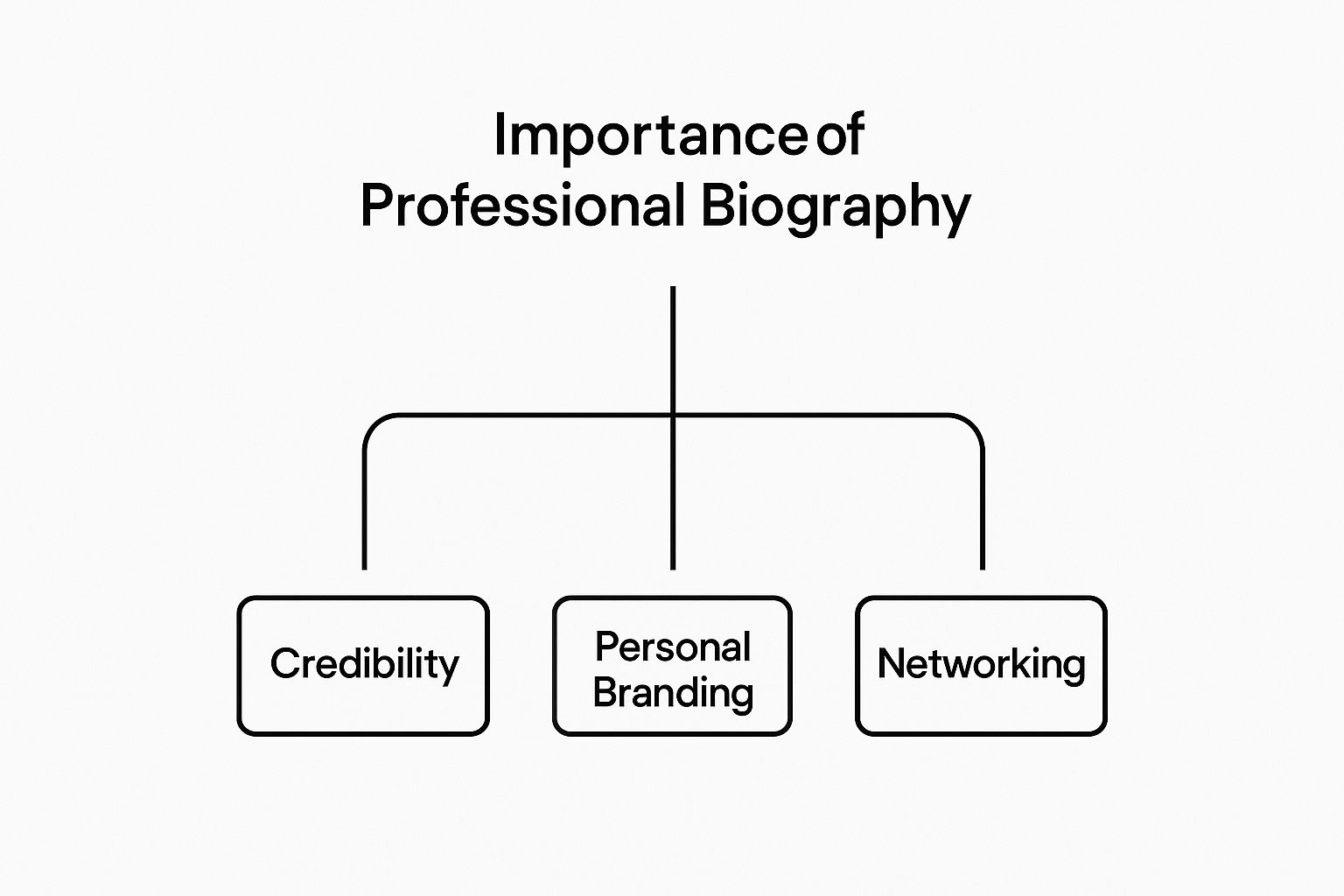
What Is a Professional Biography? Your Guide to Success
Published on 2025-06-21
What Makes a Professional Bio Essential in Today's Career Landscape
Think of a professional biography as your career's highlight reel, carefully edited for a specific audience. It's much more than just a resume squeezed into a paragraph. While a resume lists your job titles and duties, a compelling professional bio tells the story behind your work. It connects your skills and achievements into a memorable narrative that shows not just what you've done, but who you are as a professional. This difference is critical when personal branding can be just as impactful as your qualifications.
A professional biography is a concise summary of your career achievements, roles, and skills, all designed to introduce you in a professional setting. Its importance has skyrocketed with the growth of digital platforms like LinkedIn, corporate websites, and online portfolios. In fact, studies show that over 70% of professionals worldwide use some form of online bio to boost their visibility and credibility. This reflects a major shift: first impressions are now frequently made online, long before you ever shake hands.
From Simple Introduction to Career-Defining Asset
The role of a bio has changed dramatically. It's no longer a mere formality for a conference program or a company's "About Us" page. Today, it’s a dynamic tool that works for you 24/7. Recruiters, potential clients, and future collaborators use it to quickly assess your expertise, professionalism, and whether you'd be a good fit. This screening happens fast, so your bio must signal your value immediately. The biggest mistake professionals make is thinking bios are just for listing accomplishments. The most effective ones tell a story, revealing your unique perspective and professional journey.
The Power of a Purpose-Driven Bio
Different situations call for different versions of your story. The narrative you write for your LinkedIn profile to attract recruiters will be different from the one a moderator reads before your keynote speech. Each version has a distinct purpose, but they all share the goal of building credibility and creating a connection. On a platform like LinkedIn, the "About" section is prime real estate for your professional story.
The screenshot below from LinkedIn's help center shows where users can add or edit this crucial summary on their profile.

This section is your chance to frame your entire career for anyone who visits your page, making it one of the most powerful branding tools you have. Understanding what is a professional biography means seeing it as a cornerstone of your digital presence. It’s the tool that helps you control your narrative and make a lasting impression in a crowded field.
The Building Blocks of Bios That Get Results
Turning a dull list of job titles into a compelling story means understanding the core parts of a successful professional bio. Think of it like building with LEGO bricks: you have all the pieces—your skills, accomplishments, and history—but the real craft is in how you put them together. A great bio isn't a chronological report; it's a strategic narrative designed to highlight your unique value. The goal is to make a reader feel like they know you and understand what you bring to the table in just a few seconds. This requires carefully choosing which "bricks" to use and how to connect them into a memorable structure.
The following infographic shows the three pillars that a well-written bio supports: building credibility, defining your personal brand, and creating networking opportunities.

This visual shows how each part builds on the last. Credibility is the foundation for a strong personal brand, which in turn unlocks better networking.
Your Current Role as the Foundation
Start by grounding the reader in your present reality. Your current role is more than a job title; it's the anchor for your entire professional story. Explain what you do now in a clear and impactful way. Instead of saying, "Marketing Manager at Company X," try something like, "As a Marketing Manager at Company X, I lead a creative team to develop brand campaigns that have grown our audience by 30%." The second version immediately defines your function and adds a key achievement, showing your current relevance and skills.
Weaving in Achievements and Personality
With the foundation set, it’s time to add layers of expertise and personality. This is where you go beyond your duties and show your results. A strong professional bio highlights measurable achievements that prove your abilities. Instead of just listing what you were supposed to do, answer the question: "What happened because I was there?" These accomplishments are your proof.
At the same time, adding a touch of your personality makes you more than just a resume on paper. It’s what turns a credible bio into a memorable one. This careful balance is what sets an exceptional bio apart. Platforms like about.me specialize in helping professionals create a single page that blends these elements effectively.
The image below from about.me shows a clean, visual-first approach that combines professional links with a personal statement.

This example shows how a simple presentation can powerfully communicate both professional identity and personal flair, making the bio more engaging. You can explore a variety of other styles by checking out these professional bio examples for more ideas.
Calibrating Tone for Your Audience
Finally, the best bios are tuned to their intended audience. The tone and focus that work for a creative director’s portfolio will likely fall flat on a corporate leadership page. Knowing who will read your bio is critical. A bio for a tech conference might highlight specific software skills, while one for a non-profit board application would focus on community involvement and leadership.
The table below shows how the key elements of a bio can change depending on the industry and audience.
| Industry | Key Elements | Tone | Typical Length |
|---|---|---|---|
| Corporate/Finance | Career progression, quantifiable results (revenue growth, cost savings), leadership experience, education/certifications. | Formal, confident, authoritative. | 100-150 words |
| Technology | Technical skills (programming languages, tools), project highlights, contributions to open-source, innovation. | Direct, forward-thinking, slightly informal. | 75-125 words |
| Creative Arts | Artistic vision, notable projects/exhibitions, awards, personal philosophy, unique style. | Expressive, personal, passionate. | 150-250 words |
| Academia | Research interests, publications, teaching experience, degrees and affiliations, conference presentations. | Scholarly, formal, detailed. | 200-300+ words |
| Non-Profit | Mission-driven work, community impact, volunteer experience, leadership roles, personal connection to the cause. | Passionate, inspiring, community-focused. | 100-200 words |
As you can see, the industry dictates not just what you say, but how you say it. Adjusting your tone, keywords, and highlighted achievements ensures your story connects with the people you want to reach, turning your bio into a powerful tool for career growth.
From Blank Page to Personal Brand Story
Staring at a blinking cursor on a blank screen can be one of the most difficult parts of writing your professional story. You know your experiences, but turning them into a powerful summary is another challenge entirely. The best approach is to reframe the task: you aren't just listing facts; you're crafting your personal brand story, one piece at a time. This mindset turns an overwhelming job into a creative process focused on what makes you unique.
Brainstorming Your Core Value
Before you write a single sentence, you need to figure out what makes you valuable. Think past your official job duties. What kinds of problems are you great at solving? What results do you consistently achieve? This first brainstorming step is about collecting your raw materials. Don't stress about perfect wording just yet—simply get your thoughts down.
Here’s a simple exercise to get you started:
- List Your Top 5 Achievements: What accomplishments make you the most proud? Be specific and use numbers when you can (e.g., “Grew team efficiency by 25%” is more impactful than “Improved team workflow”).
- Identify Your Core Skills: What are you exceptionally good at? Include both hard skills, like data analysis, and soft skills, such as team leadership.
- Define Your Professional "Why": What motivates you at work? It could be a passion for new ideas, a dedication to helping customers, or a drive to tackle complex challenges.
This exercise helps you gather the essential "bricks" you'll use to build the foundation of your bio. The aim is to move from a generic list of responsibilities to a strong collection of impacts and motivations that truly define you.
Structuring Your Narrative
Once you have your key points, it's time to arrange them into a story. A good bio has a clear beginning, middle, and end. It needs a narrative flow that grabs the reader's attention, establishes your credibility, and closes with a memorable statement. You are not just summarizing your past; you are taking the reader on a quick tour of your career highlights.
The screenshot below from Grammarly provides a helpful model for structuring a bio, whether you need a short or long version.

The key takeaway here is that a bio should blend your professional wins with your personal interests to paint a complete and relatable picture.
Crafting a Compelling Story
With a solid structure, you can now focus on your wording. A well-written professional bio uses storytelling techniques to make your profile stick in the reader's mind.
- The Opening Hook: Begin with a strong, attention-grabbing statement. This could be your current role paired with a major achievement or a powerful declaration of your professional mission.
- The Momentum-Building Middle: Weave your accomplishments and experiences into a cohesive narrative. Connect the dots for the reader, showing how one role or project led to the next and built your expertise over time.
- The Memorable Ending: Finish with a forward-looking statement or a touch of personality. What are you excited about? What do you want the reader to do next? This final touch encourages people to connect with you.
By following this method, that intimidating blank page becomes a powerful professional tool. Your professional bio becomes more than just a summary; it’s a strategic story that defines your brand and opens the door to new opportunities.
Tailoring Your Bio for Every Professional Situation
Think of your professional biography like a go-to outfit. You wouldn't wear the same thing to a casual coffee meeting and a formal industry awards ceremony. In the same way, your bio needs to be adapted for different settings. While your core career story stays the same, how you tell it—the tone you use and the details you emphasize—must change to match the audience and platform.
A one-size-fits-all bio doesn't work because different platforms have different expectations. Your LinkedIn summary should feel different from a conference speaker intro, and both should differ from your company website profile. Customizing your bio shows you understand the context and respect your audience's time.
First-Person vs. Third-Person Perspective
One of the first choices you'll make is the point of view, which directly shapes the tone of your story.
- First-Person ("I," "me"): This perspective creates a personal and direct connection. It’s perfect for platforms where authenticity is key, like a personal blog, portfolio, or your LinkedIn summary. Using "I" makes your story feel genuine and helps you build rapport with the reader.
- Third-Person ("She/He/They"): This approach feels more formal and objective. It is often the standard for corporate websites, press releases, formal speaking events, or academic papers. Writing in the third person lends a sense of established credibility.
Adjusting Length and Focus for Maximum Impact
Beyond point of view, you need to adjust your bio’s length and focus. A bio can range from a short, punchy introduction of 50-150 words to a more detailed narrative of up to 500 words for speaking engagements or publications. A short bio for a social media profile might highlight your current role and one key achievement, while a longer version for a keynote speech could explore your career journey and major accomplishments.
To help you decide, here’s a quick guide on how to approach different bio lengths for various professional needs.
| Platform/Purpose | Word Count | Key Elements | Tone Style |
|---|---|---|---|
| LinkedIn Summary | 100-200 words | Current role, key skills, major achievements, call to action. | First-person, approachable, professional yet conversational. |
| Twitter/Social Media | 25-50 words | Job title, company, one key accomplishment or area of expertise. | First-person, concise, often informal with a hint of personality. |
| Conference Speaker | 75-150 words | Credentials, relevant expertise, a major accomplishment, topic relevance. | Third-person, authoritative, engaging, and professional. |
| Company Website | 50-100 words | Role, responsibilities, brief professional background, personal touch. | Third-person (usually), professional, aligns with company brand. |
| Guest Post/Article | 30-75 words | Name, title, area of expertise, link to website or social profile. | Third-person, concise, credible, and informative. |
| Press Release/Media Kit | 150-300 words | In-depth background, significant achievements, awards, and qualifications. | Third-person, formal, objective, and newsworthy. |
As you can see, each context calls for a slightly different version of your story. Having these variations ready makes you look prepared and professional.
For example, when preparing for a high-stakes event like a TEDx talk, organizers require specific bio lengths for different uses. The screenshot below from the official TEDx Organizer Guide shows how they ask for multiple versions. You can find more details in the TEDx Organizer Guide.
This example makes it clear that a single bio isn't enough. You need a short version for introductions, a medium one for the program, and a longer one for the website. By having these ready, you make it easy for event coordinators, journalists, and potential partners to feature you correctly.
Writing Bios That Reflect Modern Workplace Values
The professional world is always changing, and so are the expectations for how we present ourselves. A modern professional bio is no longer a sterile list of accomplishments; it's a dynamic document that shows you understand today's workplace and helps you build real connections. Smart professionals are now writing bios that signal inclusivity, share personal values, and tell a more human story, leaving behind the stiff, corporate tone of the past. This isn't just about sounding up-to-date—it's about connecting on a meaningful level with colleagues, clients, and employers who see the world the way you do.
Embracing Inclusivity and Authenticity
One of the biggest changes in how we present ourselves professionally is the move toward more inclusive language. Think of your bio as your digital handshake—it should be welcoming to everyone. This includes making it normal to share your preferred pronouns. By adding pronouns (like she/her, he/him, or they/them) to your bio on platforms like LinkedIn or your company website, you show you're an ally and help create a more welcoming culture. It's a small action that can make a big difference in how people see you.
The screenshot below from Harvard's Diversity, Inclusion, and Belonging office shows how simple and important sharing pronouns can be.
This guidance highlights that stating your pronouns is a key step in building a space where everyone feels respected and seen. This is quickly becoming a standard professional practice. Data shows a clear trend toward more personalization and inclusivity. For example, in the legal world, a growing number of firms are adding gender identity and preferred pronouns to their attorney bios. In fact, over 60% of firms in top legal markets are expected to adopt this practice to show their commitment to diversity. You can learn more by checking out the latest research on attorney bio trends on paperstreet.com.
Weaving Your Values into Your Narrative
Beyond being inclusive, modern bios are also driven by values. Instead of just listing what you do, successful professionals are explaining why they do it. A values-based statement acts like a compass, pointing readers to the heart of who you are professionally. For example, a software developer could go beyond listing programming languages and say, "I am passionate about building technology that is accessible to all users, regardless of ability." This tells a much more interesting and memorable story.
This storytelling approach, which mixes professional achievements with personal motivations, has been shown to create much stronger connections. When you share a piece of your personality—whether it’s a passion for sustainability, a commitment to mentoring others, or a love for creative problem-solving—you become more relatable. These elements are crucial for helping you build your personal brand on LinkedIn and other professional sites. It’s about creating a three-dimensional picture of yourself, not just a flat summary of your resume.
Leveraging Technology While Staying Authentic
AI tools are also changing how we create bios, offering a good starting point for anyone stuck on a blank page. These tools can help organize your thoughts and suggest powerful phrases. The trick, however, is to use technology as a co-pilot, not an autopilot. Your authentic voice, unique experiences, and personal values are what truly make your story stand out. An AI-generated draft should always be revised with your personality and specific accomplishments to make sure it sounds like you. The goal is to blend the efficiency of technology with human authenticity, creating a professional bio that is both polished and deeply personal.
Your Bio as a Strategic Career Advancement Tool
Your professional bio is much more than a simple summary of your career; it’s a powerful asset that actively works to advance your professional goals. In a competitive market where attention is a valuable resource, your bio often acts as the first point of contact for potential clients, collaborators, and employers. Think of it as your digital handshake, making an impression long before you even know you’re being considered. This narrative isn't just about listing past jobs; it's about framing your expertise to drive real results, from landing a new client to securing a better position.
Consider your bio the bridge connecting your experience to your next big opportunity. Its format and importance have grown right alongside major shifts in the global workforce. The professional and business services sectors—which include high-stakes fields like consulting, legal services, and technology—are perfect examples. According to recent employment data, these sectors employ over 20 million people in the U.S. alone, and everyone in them depends on a compelling professional biography for networking, winning clients, and moving up. To see more on employment patterns in these key industries, you can explore the current employment statistics highlights from the BLS.
The Bio as a Business Development Engine
In fields where credibility is everything, a well-written bio directly fuels business growth. For a consultant, a bio that highlights specific, successful project outcomes can be the deciding factor for a potential client. Similarly, a lawyer’s bio that points to key case wins and specialized knowledge builds immediate trust. In the tech world, a bio detailing contributions to major projects or expertise in new technologies establishes an individual as a forward-thinking leader.
The screenshot below from the Bureau of Labor Statistics' Occupational Outlook Handbook offers a glimpse into the huge range of professional fields where a strong bio is critical for career growth.

This resource highlights the diversity of career paths available, each needing a tailored professional story to stand out and communicate value to a specific audience.
Gaining a Competitive Edge in Recruitment
The move toward remote and hybrid work has made a skills-focused professional biography more important than ever. Recruiters and hiring managers often use platforms like LinkedIn to find and vet candidates, making your bio a primary screening tool. A generic summary won’t grab their attention. However, one that strategically showcases in-demand skills, measurable achievements, and a clear career path can put you at the top of their list. This is especially true for professionals looking to switch industries or step into leadership roles.
Successful professionals understand this and use their bios as active tools for career growth by:
- Targeted Networking: Shaping their story to attract specific connections, such as investors, mentors, or industry peers.
- Client Acquisition: Using their bio on websites and proposals to establish authority and turn leads into clients.
- Career Advancement: Regularly updating their bio to reflect new skills and accomplishments, signaling they are ready for the next challenge.
Ultimately, knowing what a professional biography is means understanding its role as a strategic narrative. It’s the story you tell the world about the value you bring. By investing time in creating a compelling and authentic bio, you aren't just documenting your past; you are actively building your future. For those looking to improve their professional story on key platforms, check out our guide on creating an effective content strategy for LinkedIn.
Avoiding Pitfalls and Implementing Your Bio Strategy
Crafting a compelling professional bio is a skill. And like any other skill, there are common mistakes that can dilute your message. Professionals often stumble into traps like downplaying their accomplishments or clouding their story with too much industry jargon. The goal is to strike a balance between confident promotion and genuine approachability, creating a bio that is both trustworthy and memorable. This prevents you from writing a generic summary that simply fades into the background.
Understanding what not to do is just as critical as knowing what to include. Here are a few common pitfalls to sidestep:
- The Vague Accomplishment: Claiming you "improved team performance" is far less impactful than saying you "led a project that boosted team productivity by 20%." Always use specific numbers and tangible results.
- The Jargon Overload: Relying on technical terms and acronyms can confuse readers who aren't in your direct field. Aim to write for a wider audience, explaining complex concepts in straightforward terms.
- The "Set It and Forget It" Approach: Your career is dynamic, and your bio should be too. An outdated bio can suggest you're not actively engaged in your field. Make a plan to review and refresh it at least twice a year or after any major career milestone.
From Good to Great: Fixing Ineffective Bios
A great bio does more than list your achievements; it weaves them into a convincing story. It connects with the reader by showing your personality and what makes you unique. A frequent mistake is creating a bio that is technically accurate but completely lacks personality, making it difficult for anyone to remember you.
The screenshot below, from a HubSpot article on professional bio examples, showcases several bios that successfully blend professionalism with a human touch.
What these examples demonstrate is that a small bit of personality—like mentioning a personal passion or a hobby—can make a professional bio more relatable and human.
Your Bio Implementation Roadmap
Now that you understand what a professional biography is and its main parts, it’s time to apply that knowledge. Use this simple framework to build and execute your bio strategy.
- Conduct a Personal Inventory: Before you start writing, make a list of your biggest achievements, primary skills, and professional values. What outcomes are you most proud of?
- Draft Your Core Story: Using your list, write a "master" bio in the third person. Concentrate on building a narrative that links your experiences and showcases your unique professional path. Don't worry about the length just yet.
- Tailor and Test: Develop different versions of your bio for specific platforms like LinkedIn, your company website, or speaker profiles. Adjust the tone (first-person vs. third-person) and length to fit each context.
- Gather Feedback: Ask a trusted colleague or mentor to review your bio. Is it clear, compelling, and authentic? An outside viewpoint is essential for catching awkward phrasing or identifying missed opportunities.
- Measure and Refine: Observe how people respond. Are you receiving more connection requests on LinkedIn? Are people at networking events bringing up your bio? Use this input to make ongoing improvements.
Tired of staring at a blank page? Let autoghostwriter help you create an authentic, engaging LinkedIn presence in just a few clicks. Our AI-powered platform gives you proven templates and ideas to write posts that grab attention and build your professional brand. Start creating powerful content today at autoghostwriter.com.